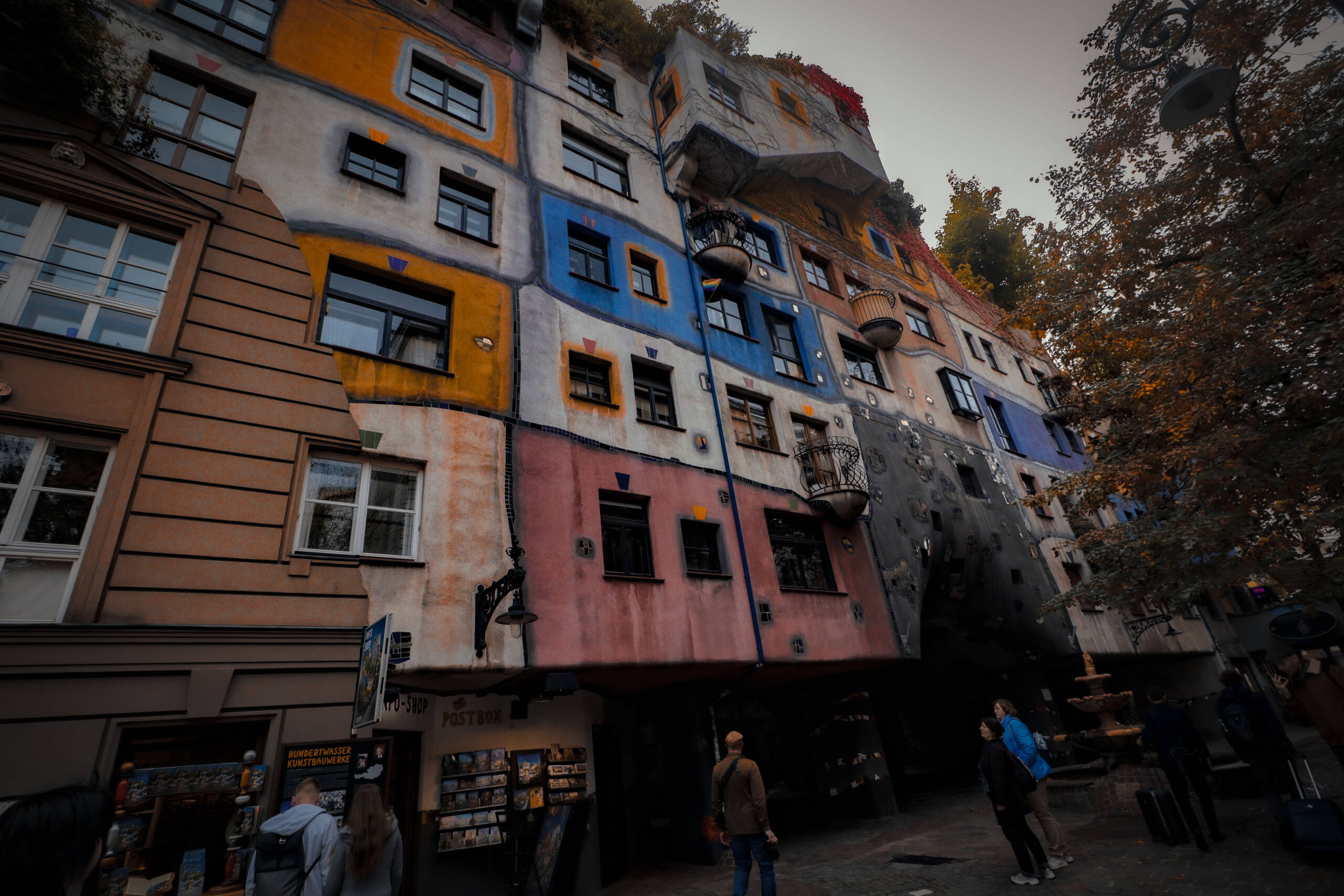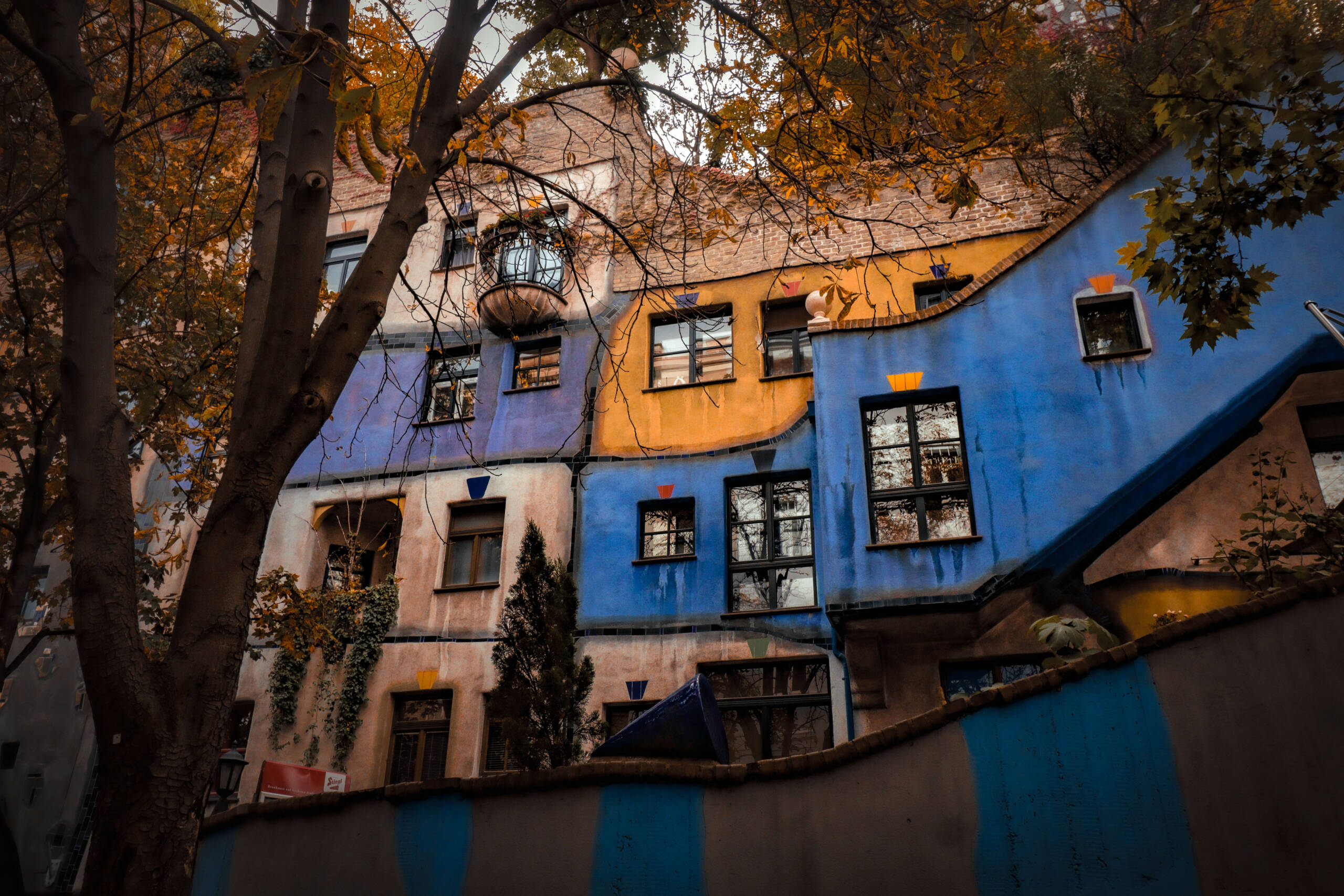Vienna is often celebrated for its imperial palaces, stately concert halls, and the orderly elegance of its boulevards, but tucked away in the Landstraße district there’s a corner of the city that feels more like stepping into an artist’s dream. The Hundertwasserhaus, designed by the eccentric Austrian painter and architect Friedensreich Hundertwasser, refuses the discipline of straight lines and uniform façades. Instead, it bursts forth with irregularity, colors that collide rather than align, and shapes that seem to have grown organically rather than been drawn on an architect’s blueprint. And when autumn drapes itself across the city, this building somehow becomes even more alive, as though the season itself was collaborating with Hundertwasser in his mission to soften the rigidity of modern life.

In the image, the façade immediately overwhelms with its patchwork of color—mustard yellows, terracotta reds, deep cobalt blues, and chalky pinks stitched together like a giant quilt. Each window is framed differently, some accentuated with painted triangles, others surrounded by uneven brushstrokes, as though the building were dressed in mismatched patterns on purpose. A conventional architect would have winced at the unevenness, but Hundertwasser cherished these differences, believing every person deserved a unique “window right,” where individuality could be literally built into the walls. In autumn, the play of sunlight and shadow across these tones blends perfectly with the surrounding trees. Their leaves, caught in the middle of their seasonal transformation, mirror the ochres and reds of the walls, as though nature and architecture are in an ongoing conversation.
It’s not only color that makes Hundertwasserhaus feel alive—it’s the way it incorporates nature at every level. From the roof sprout trees and bushes that look as if they’ve claimed their rightful place on the structure, spilling downward with roots and branches that defy the line between man-made and organic. In the crisp fall air, you can see the crowns of these trees tinged with gold and red, blending seamlessly into the canopy of the street below. The whole building seems to breathe with the same rhythm as the season, as if it were less a block of apartments and more a hillside that had simply sprouted windows.

At street level, the atmosphere is playful and inviting. Small shops tucked under the irregular arches sell Hundertwasser-inspired souvenirs, colorful postcards, and quirky art books. In the photo, visitors are caught in moments of wonder—some craning their necks to admire the eccentric balconies, others quietly observing the way the walls seem to melt into one another. A small fountain sits to the right, water trickling into its basin as people gather around it, half tourists, half accidental philosophers, reflecting on why such whimsy feels so comforting in a city usually associated with discipline and formality. The air has that cool heaviness of autumn, and you almost imagine the faint smell of roasted chestnuts or damp leaves drifting nearby.
Friedensreich Hundertwasser himself was something of a crusader against monotony. He often proclaimed that “the straight line is godless” and argued that buildings should adapt to human beings, not the other way around. He railed against the soulless grids of postwar architecture, insisting that homes should have irregular floors, walls that refused to be symmetrical, and facades that allowed for color, imperfection, and even chaos. Hundertwasserhaus, completed in 1985, became his most famous built manifesto. It is still lived in today—real tenants occupy the patchwork apartments, their daily lives unfolding behind the irregular windows, which gives the building its curious energy. It is not frozen in time like a museum, but instead it shifts with the lives within it, much as trees do with the seasons.
Autumn seems to highlight this philosophy more than any other season. Summer’s brightness can feel too uniform, winter’s gray too stark, and spring’s greens too fresh. But autumn, with its patchwork of decay and vibrancy, its imperfect leaves scattered across cobblestones, feels like the season Hundertwasser himself would have painted. The leaves cling unevenly to branches, just as colors cling unevenly to his walls. Shadows lengthen in distorted ways across the façade, making the irregular balconies and jutting overhangs seem even stranger. Even the worn patches of paint, faded slightly with age, look like natural weathering, as though the building had chosen to molt in sympathy with the trees.
Standing before it in fall, there’s a kind of quiet comfort in realizing how deliberately human the building feels. Unlike most landmarks, which dominate you with scale or impress you with perfection, Hundertwasserhaus invites you to accept imperfection as beautiful. It feels as though the building itself is whispering: life doesn’t need to be aligned to be meaningful, and beauty isn’t found in the flawless but in the surprising, the playful, the irregular. Autumn amplifies that whisper, reminding you that everything, from trees to architecture to ourselves, is always in a state of uneven, messy transformation—and that’s not something to hide, but something to celebrate.
Leave a Reply